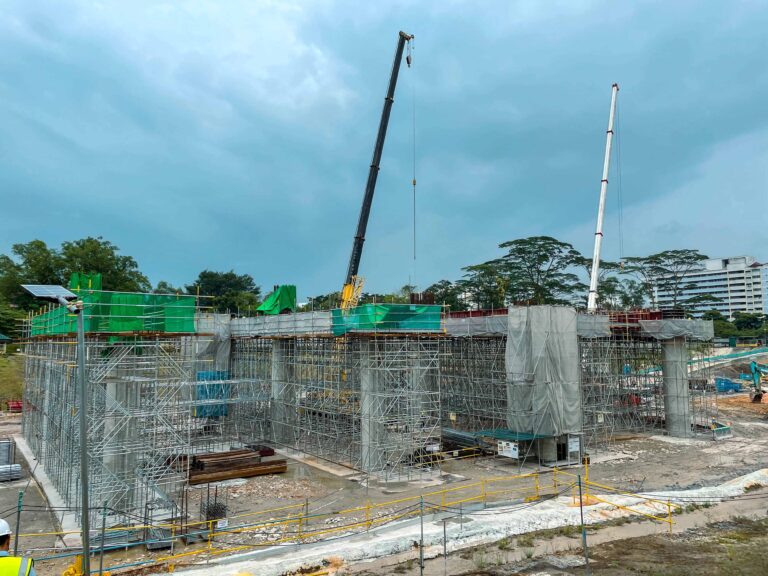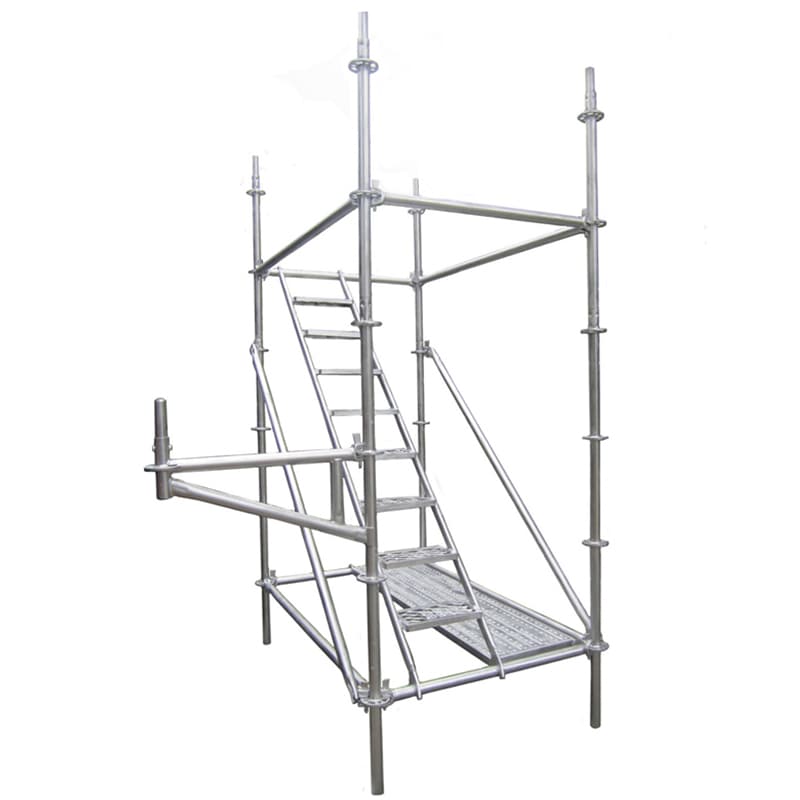Navigating the world of construction can often feel like traversing through a labyrinth of choices. One such critical decision is the selection of scaffolding. So, what influences this decision? Strength? Flexibility? Or perhaps, a combination of both? You’re probably wondering, “which scaffolding is stronger?” It’s a crucial question that could significantly impact your construction project’s success, and yet, the answer isn’t as straightforward as one might expect.
The answer to the question, “Which scaffolding is stronger?” is multifaceted. It isn’t a simple matter of comparing the inherent strength of various scaffolding types, but rather a complex issue that depends on numerous factors, such as the materials used, the quality of construction, and the skill with which the scaffolding is assembled and used.
In terms of material strength and ability to support heavy loads, systems like tube and coupler scaffolding, ringlock scaffolding, and kwikstage scaffolding are typically recognized as some of the strongest due to their robust construction and the high-strength steel they’re often made from.
However, it’s essential to remember that the ‘strongest’ scaffolding isn’t necessarily the ‘best’ scaffolding for every situation. The right scaffolding for a particular project will depend on the specific requirements of that project, including the nature of the work being performed, the weight of the loads the scaffolding will need to bear, the environmental conditions, and the skills and training of the workers who will be using the scaffolding.
Ultimately, the strength of scaffolding is only one aspect of its suitability. Safety, adaptability, ease of assembly, and compliance with regulations and standards are all crucial factors to consider when choosing the right scaffolding for your project.
In conclusion, while certain types of scaffolding may be inherently stronger due to their materials and design, the strongest scaffolding for a particular project is the one that best meets that project’s specific needs while ensuring the safety of all workers involved.
In the following sections, we’ll dive deeper into these factors, scrutinizing the strengths and characteristics of different types of scaffolding. Our objective is to equip you with the knowledge you need to make an informed decision, one that ensures not just the success of your project, but also the safety of your crew. So, let’s roll up our sleeves and delve into the world of scaffolding!
Table of Contents
ToggleUnderstanding the Basics of Scaffolding
What is Scaffolding?
At its core, scaffolding is a temporary structure erected around or inside a building during construction or repair. It serves as a sort of ‘stairway to the skies,’ providing workers a safe, stable platform to carry out their tasks, often several feet above the ground. But is scaffolding merely a platform to stand on? Absolutely not! It’s much more than that.
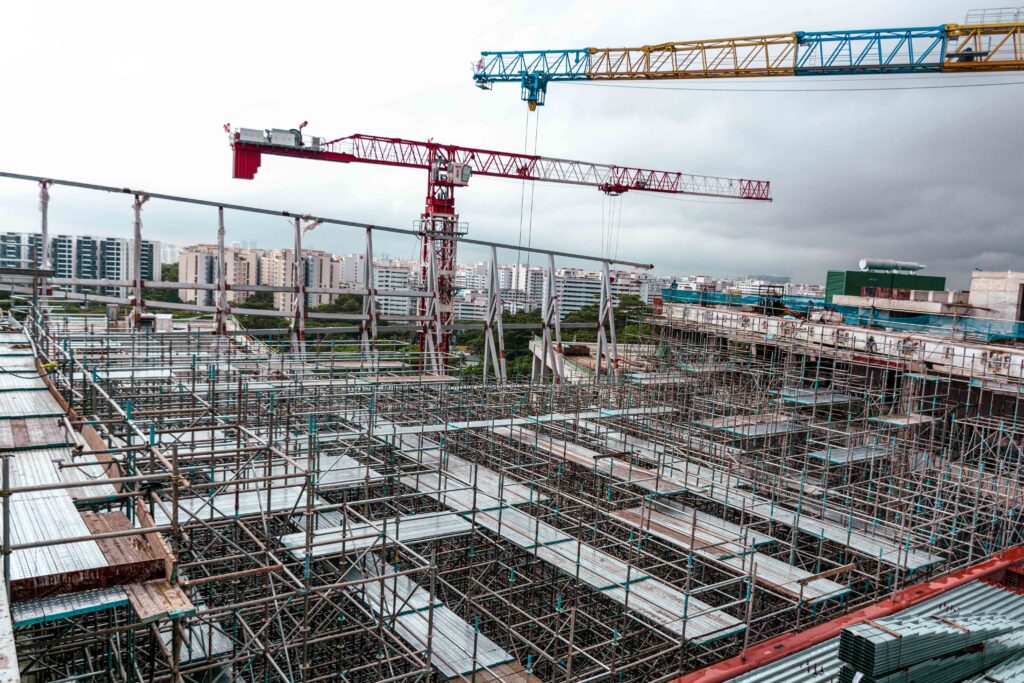
Think of scaffolding as the vascular system of a construction site. It transports workers, tools, and materials from the ground to higher levels, much like our veins and arteries carry blood from our heart to the rest of the body. This comparison is not coincidental. Scaffolding is indeed the lifeblood of any construction project.
Importance of Scaffolding in Construction
The importance of scaffolding in construction cannot be overstated. But why is it so crucial? Let’s break it down:
Safety: Safety is paramount in any construction project. Scaffolding provides a safe, elevated platform for workers, reducing the risk of falls and accidents. It also comes with safety rails and toe boards for added protection. Remember, a safe worker is a productive worker!
Accessibility: Construction projects often require work at various heights and hard-to-reach places. Scaffolding serves as a bridge, granting workers access to these areas that would otherwise be inaccessible.
Efficiency: Imagine having to ascend and descend a ladder every time you need a tool or a construction material. Sounds exhausting, right? Scaffolding eliminates this hassle. It allows multiple workers and materials to be on the same level simultaneously, thereby increasing efficiency and reducing construction time.
Load Capacity: Scaffolding can support significant weight loads, from workers and building materials to heavy equipment. This ability to bear weight is essential in maintaining the smooth flow of construction activities.
Versatility: From building new structures and carrying out repairs to painting and cleaning, scaffolding finds its use in a wide array of tasks in the construction field.
Scaffolding, hence, is more than a mere structure; it’s an integral component that contributes to the successful and timely completion of a construction project. It ensures safety, facilitates efficiency, and above all, it stands as a testament to the marvel of human engineering.
Different Types of Scaffolding
The construction industry boasts an array of scaffolding types, each designed to cater to specific project requirements and scenarios. Here, we will delve into various scaffolding types and their unique characteristics, enabling you to identify the one that best fits your project’s needs.
Tube and Coupler Scaffolding
Tube and coupler scaffolding, also known as tube and fitting or tube and clamp scaffolding, is a versatile and highly adaptable system. It consists of steel or aluminum tubes connected using couplers and clamps, allowing for a wide range of configurations.
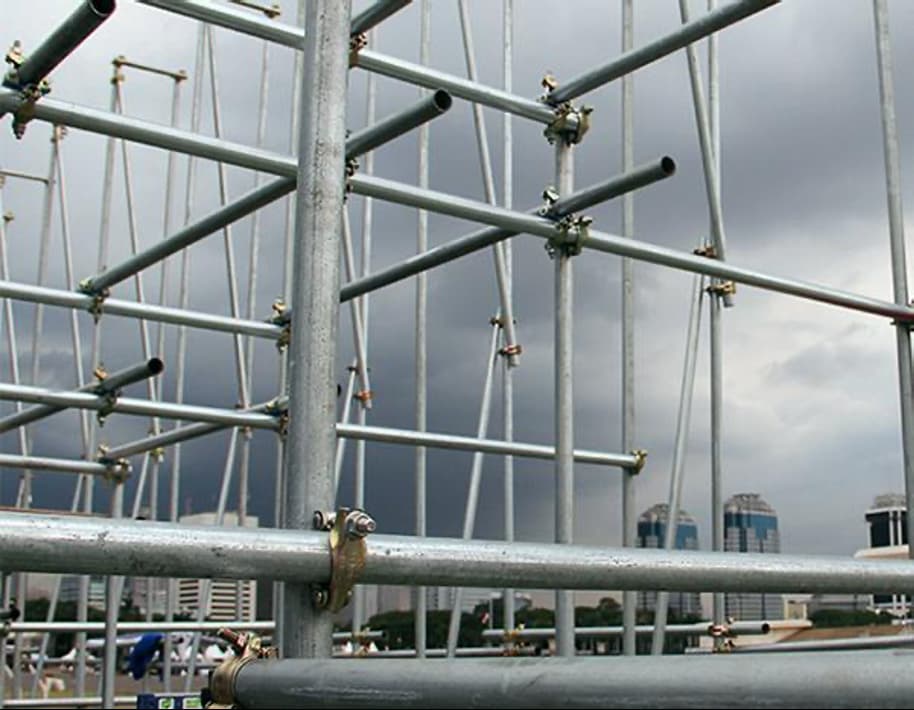
Pros:
- Highly flexible, making it suitable for complex and irregular structures.
- Can be assembled in various configurations, allowing for customization based on project requirements.
- Strong and durable, providing a safe and stable working platform.
Cons:
- More labor-intensive and time-consuming to erect and dismantle compared to other types.
- Requires skilled workers to assemble correctly.
Frame Scaffolding
Frame scaffolding, sometimes referred to as facade or modular scaffolding, is a prefabricated system consisting of welded frames and cross braces. It’s easy to assemble and disassemble, making it popular for small to medium-sized projects.

Pros:
- Quick and easy to set up and dismantle, saving time and labor costs.
- Provides a stable and secure working platform.
- Ideal for projects requiring a high level of mobility.
Cons:
- Less adaptable than tube and coupler scaffolding, limiting its use in complex structures.
Mobile Scaffolding
Mobile scaffolding, or rolling scaffolding, is a freestanding, independent scaffold mounted on casters or wheels. This feature allows for easy movement and repositioning, making it ideal for tasks that require frequent changes in location.
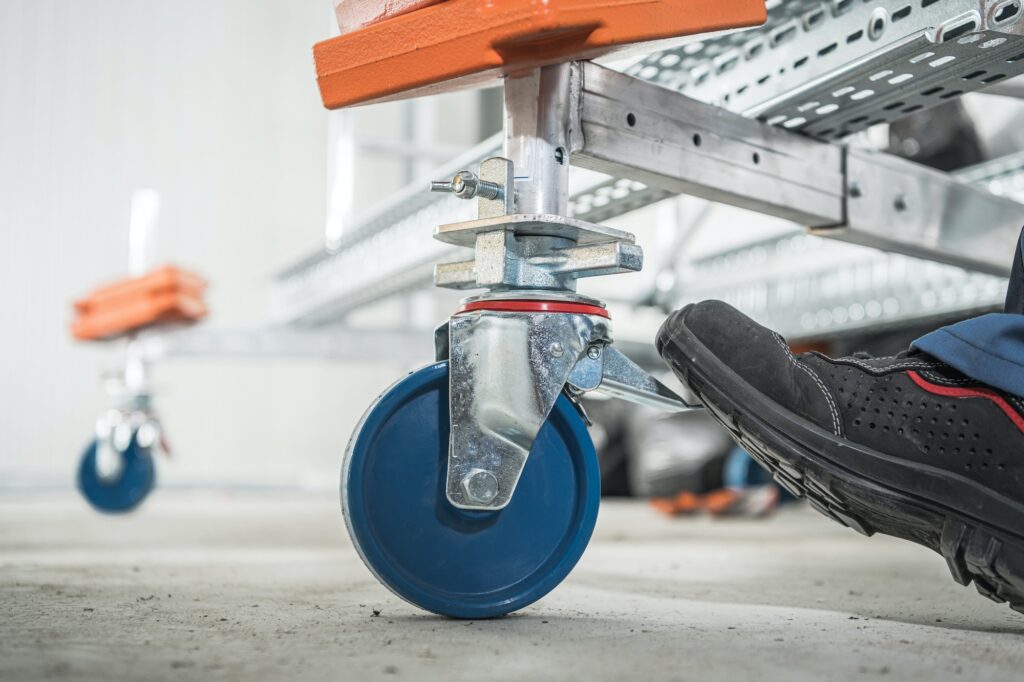
Pros:
- Highly mobile, allowing workers to move the scaffold without disassembling it.
- Quick and easy to set up and dismantle.
- Provides a stable working platform
Cons:
- Not suitable for uneven terrain, as it requires a level ground for stability and safety.
- May not be as sturdy as stationary scaffolding, especially for heavy loads.
Suspended Scaffolding
Suspended scaffolding, also known as swing stage scaffolding, consists of a platform that hangs from the top of a building or structure, using ropes or wires. It is most commonly used for tasks like window washing, painting, or repairs on high-rise buildings.

Pros:
- Highly adaptable and can be raised or lowered to different heights, allowing for easy access to hard-to-reach areas.
- Ideal for work on high-rise buildings where ground-based scaffolding is impractical.
- Provides a secure and stable working platform.
Cons:
- Requires a high level of safety measures due to its suspended nature.
- Not suitable for heavy loads.
- Requires trained professionals for proper and safe operation.
Cantilever Scaffolding
Cantilever scaffolding, also known as needle beam scaffolding, is a type of scaffolding where the platform is supported by cantilevered load-bearing members. This type of scaffolding is often used when the ground surface doesn’t allow for a standard scaffolding setup, like over sidewalks or other obstacles.
Pros:
- Ideal for situations where the ground surface is unsuitable for standard scaffolding.
- Allows for work above obstacles without disrupting the area below.
- Provides a secure and stable working platform.
Cons:
- Requires careful design and construction to ensure stability.
- Not suitable for heavy loads.
- Generally more expensive due to the complex construction.
Ringlock Scaffolding (Allround Scaffolding, Rosette Scaffolding, Multidirectional Scaffolding)
Ringlock scaffolding, also known as allround scaffolding, rosette scaffolding, or multidirectional scaffolding, is a highly versatile modular scaffolding system. It is distinguished by its ring-shaped nodes or rosettes, with multiple connection points that allow various components like vertical standards, horizontal ledgers, and diagonal braces to connect, enabling a wide range of configurations.

Pros:
- Exceptionally versatile and adaptable, making it suitable for a multitude of structures, including those with complex and irregular shapes.
- Quick and straightforward to set up and dismantle, which can lead to significant time and labor cost savings.
- Provides a robust and stable working platform capable of supporting heavy loads, ensuring the safety of workers.
Cons:
- Tends to be more expensive than some other scaffolding systems due to its specialized components.
- Requires skilled labor for proper assembly and use, which may increase labor costs.
Ringlock (or Allround, Rosette, or Multidirectional) scaffolding is a popular choice in the industry, particularly for projects with complex structural requirements. Its unique design and robust construction make it a reliable choice that ensures both the efficiency of the project and the safety of the workers. It is crucial to remember, however, that the suitability of this or any other scaffolding system ultimately depends on the specific needs and conditions of the project at hand.
Cuplock Scaffolding
Cuplock scaffolding, sometimes referred to as cup and lock or cup system scaffolding, is a popular prefabricated scaffolding system. It uses unique cup-shaped connectors at the junction points, allowing for a secure and fast connection between the vertical standards and horizontal ledgers.

Pros:
- Quick and easy to assemble and disassemble, making it time and cost-efficient.
- Highly adaptable, suitable for a wide range of applications, including load-bearing structures and support systems.
- Provides a strong and stable working platform that can support heavy loads.
Cons:
- May not be as versatile as tube and coupler or ringlock scaffolding for complex structures.
- Requires skilled workers for proper assembly and use.
Kwikstage Scaffolding
Kwikstage scaffolding, often referred to as Quickstage or Kwikform, is a modular scaffolding system renowned for its strength and ease of use. It features a distinctive wedge fixing mechanism that allows for quick assembly and disassembly, making it a preferred choice for many construction projects.

Pros:
- Quick and easy to assemble and disassemble, significantly reducing labor costs and construction time.
- Highly durable and robust, capable of supporting heavy loads. This makes it ideal for both small-scale and large-scale projects.
- Offers a secure and stable working platform, contributing to the safety of workers.
Cons:
- Less flexible compared to some other scaffolding types, like tube and coupler or ringlock scaffolding.
- Requires professional expertise for proper and safe assembly.
In the world of scaffolding, Kwikstage represents a reliable choice that balances strength, efficiency, and safety. As with other scaffolding types, the suitability of Kwikstage scaffolding for your project will depend on specific requirements, site conditions, and the nature of the work being performed. The more comprehensive your understanding of these scaffolding systems, the better equipped you will be to make an informed decision that ensures both the success of your project and the safety of your team.
Each of these scaffolding types has its unique strengths and limitations. The choice of the right scaffolding depends on the specific requirements of your project, including the nature of the work, the site conditions, the load-bearing requirements, and the available resources. Understanding these factors can help you make a well-informed decision that ensures the success of your project while prioritizing the safety of your workers.
Strength Comparison Among Different Scaffolding Types
After exploring the vast array of scaffolding types, it’s natural to ask: “Which scaffolding is stronger?” Strength and durability are crucial factors to consider when choosing a scaffolding system, as they directly impact the safety of the workers and the overall success of the project. Let’s delve deeper into the strength comparison among the different types of scaffolding we’ve discussed, taking into account their materials and construction.
Tube and Coupler Scaffolding
This type of scaffolding is often constructed from durable materials like steel or aluminum, providing robust support for workers and materials. However, the strength of tube and coupler scaffolding heavily relies on the skill of the workers assembling it. When erected correctly, it can support heavy loads and withstand harsh conditions, making it one of the strongest scaffolding types available.
Frame Scaffolding
While frame scaffolding is generally not as adaptable as tube and coupler scaffolding, it is crafted from strong steel or aluminum, offering a sturdy and reliable structure. It’s best suited for less complex structures and can provide a safe and stable platform when assembled correctly.
Mobile Scaffolding
Despite its mobility, mobile scaffolding is not to be underestimated in terms of strength. Often made from lightweight yet robust materials like aluminum, it can provide a secure platform for light to medium loads. However, it may not be as suitable for heavy loads as some other scaffolding types.
Suspended and Cantilever Scaffolding
Suspended and cantilever scaffolding systems are typically not used for heavy loads due to their design. They’re often constructed from steel or aluminum and can support workers and their tools effectively but are not designed to bear the weight of heavy construction materials.
Ringlock (Allround, Rosette, Multidirectional) Scaffolding
Ringlock scaffolding, made from high-strength steel, is designed for strength and versatility. Its unique design allows it to support heavy loads, making it one of the strongest types of scaffolding available. It is often used in large-scale construction projects that require a robust and reliable support system.
Cuplock and Kwikstage Scaffolding
Cuplock and Kwikstage scaffolding systems are renowned for their strength. Made from high-quality steel, they are capable of supporting heavy loads and are often used in both small-scale and large-scale construction projects.
In conclusion, the strength of a scaffolding system depends on its design, the materials it’s made from, and how well it’s assembled. While some scaffolding types inherently provide more strength due to their materials and construction, the choice should always be tailored to the specific requirements of the project, considering factors such as the nature of the work, the weight of the load, and the environmental conditions. Always prioritize safety and ensure your choice complies with local regulations and standards.
Ease of Assembly Among Different Scaffolding Types
While strength and durability are vital considerations when choosing scaffolding, ease of assembly is another crucial factor. Faster and simpler assembly can significantly reduce labor costs and construction time, positively impacting the overall project timeline and budget. Let’s examine the ease of assembly among the different scaffolding types.
Tube and Coupler Scaffolding
Tube and coupler scaffolding is highly flexible, but this versatility comes with complexity. The assembly of this type of scaffolding requires skilled workers and more time due to its detailed connection points.
Frame Scaffolding
Frame scaffolding, in contrast, is one of the easiest and quickest to assemble. Its standard frame and cross braces simply slot together, making it ideal for smaller projects or situations where quick setup and teardown are required.
Mobile Scaffolding
Mobile scaffolding is also relatively easy to assemble, with its castor wheels providing added convenience for movement. However, care must be taken to ensure that all parts are securely fastened to maintain stability.
Suspended and Cantilever Scaffolding
The assembly of suspended and cantilever scaffolding requires more expertise due to their unique designs. Suspended scaffolding, in particular, requires precise setup to ensure the safety of workers in the elevated platform.
Ringlock (Allround, Rosette, Multidirectional) Scaffolding
Ringlock scaffolding provides a good balance between versatility and ease of assembly. Its standard parts and straightforward connection points make assembly more straightforward than tube and coupler scaffolding, although it still requires some skill and understanding.
Cuplock and Kwikstage Scaffolding
Cuplock and Kwikstage scaffolding systems are designed for quick and easy assembly. Their unique connection points, such as the cup-shaped connectors in Cuplock scaffolding and the wedge fixing mechanism in Kwikstage scaffolding, enable faster setup and teardown compared to traditional systems.
In summary, while some scaffolding types are easier and quicker to assemble than others, the choice should always consider the specific project requirements and the skills of the workers. As always, safety should be the top priority, regardless of how easy a scaffolding system is to assemble.
Factors Determining the Strength of Scaffolding
Material Used
The strength of scaffolding primarily depends on the material used. Commonly, steel or aluminum is used due to their durability and strength.
Design of the Scaffolding
The design and configuration of the scaffolding structure also significantly impact its strength. Proper design ensures that the weight is evenly distributed, which enhances stability and strength.
Quality of Construction and Assembly
The quality of construction and assembly can make a huge difference in the strength of scaffolding. Poorly assembled scaffolding can lead to instability and accidents, regardless of the quality of the materials used.
The Role of ScafoTech in Providing Strong Scaffolding
Customization to Meet Specific Needs
At ScafoTech, we specialize in providing customized scaffolding solutions to meet your specific needs. We understand that each construction project has unique requirements, and we tailor our products accordingly to ensure the highest strength and safety.
Quality Assurance and Certification
Our products are certified by TUV, SGS, OSHA, and ANIS, ensuring they meet international safety and quality standards. Our commitment to quality means you receive only the strongest, most reliable scaffolding.
Conclusion
Choosing the right scaffolding involves a detailed understanding of the project’s needs and the various types of scaffolding available. While the strength of scaffolding can vary based on its type and the quality of materials used, the assembly’s quality and design also play a crucial role. At ScafoTech, we are dedicated to providing superior scaffolding solutions, customized to meet your project’s specific needs.
FAQs
- What is the strongest type of scaffolding?
- While the strength can vary based on various factors, tube and coupler scaffolding is generally considered to be one of the strongest due to its flexible design.
- How does ScafoTech ensure the strength of their scaffolding products?
- At ScafoTech, we use superior quality materials, follow stringent design protocols, and ensure quality assembly. Our products are also certified by international safety and quality standards.
- Can the strength of scaffolding be customized to meet specific project needs?
- Yes, at ScafoTech, we specialize in providing customized scaffolding solutions to meet the specific needs of your project.
- What role does the quality of assembly play in the strength of scaffolding?
- Quality of assembly plays a crucial role in scaffolding strength. Poorly assembled scaffolding can lead to instability and accidents, regardless of the material quality.
- Is steel scaffolding stronger than aluminum scaffolding?
- Steel scaffolding is generally stronger and more durable than aluminum scaffolding, making it suitable for heavy-duty work. However, aluminum scaffolding is lighter and more resistant to corrosion, making it a good choice for lighter work and in corrosive environments.
- Can I determine the strength of scaffolding by its type alone?
- No, the strength of scaffolding is influenced by many factors, including its material, design, quality of construction, and assembly. A scaffolding type that is typically strong can be weak if poorly constructed or assembled.
- Is the strongest scaffolding also the safest?
- Not necessarily. Safety depends on many factors, including the correct assembly, use, and maintenance of the scaffolding, and whether it is suitable for the specific conditions of the project. Even the strongest scaffolding can be unsafe if used incorrectly or inappropriately.
- How can I ensure the strength and safety of my scaffolding?
- To ensure the strength and safety of your scaffolding, always source from reputable manufacturers, ensure correct assembly according to manufacturer guidelines, perform regular inspections, and provide adequate training to all workers using the scaffolding.
- Can scaffolding strength be increased?
- Yes, scaffolding strength can often be increased by using stronger materials, adding additional bracing or support, or modifying the design. However, any changes should be made under the guidance of a qualified professional to ensure safety.



